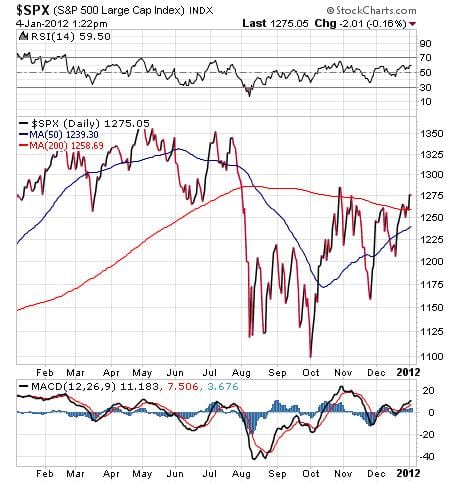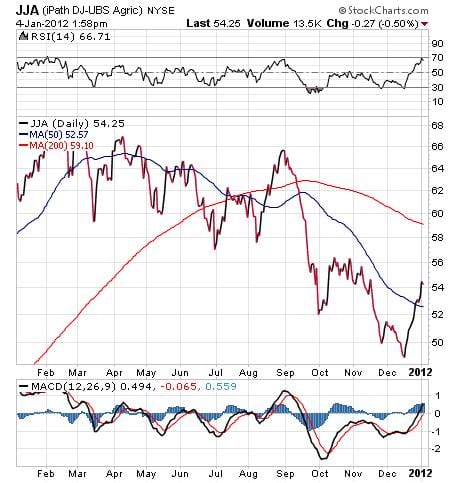[youtube_sc url=”http://youtu.be/gUDf84SWDqA”]
Tuesday was the inaugural day of 2012 trading, and we witnessed a whole lot of bullish action. In fact, I think that the New Year’s Eve party that began last Saturday night in Times Square may have spilled over onto Wall Street on Tuesday. Markets were up big across the board, not only here in the United States, but also in Europe and Asia.
The surge in stocks put the S&P 500 Index back above its 200-day moving average and, as I write this article, the broad measure of the domestic equity market sits just over the 1,275 mark.

Despite this latest kick higher by the bulls, I think we likely are witnessing another bullish head fake that is similar to the kind we saw in October, November and again in early December.
As you likely know, I’ve been saying that stocks could undergo a relief rally of up to 5%, as many hedge fund and money managers try to position their portfolios for growth at the beginning of the year. This early-year exuberance is understandable but, unfortunately for the bulls, I believe it’s imminently unsustainable.
Certainly, we could see stocks move even higher from here. However, I think the prevailing dual headwinds of Europe’s debt crisis and China’s economic cool down will continue dragging stocks lower for some time to come.
I currently am advising readers of my Successful Investing advisory service to remain cautious with respect to their allocations to this market. I think there is just way too much potential peril here, and that means diving in head first in this shallow market water could result in serious injury to your wealth.
Now, if we do see stocks mount a significant rally from here, and if that rally proves it has legs, then you’ll want to begin adding equity exposure. Until then, however, the prudent investor should sit tight with a big wad of cash.
________________________________________
Personal Finance Exercises for the New Year, Part I
It’s 2012, and that means now is a great time to get your fiscal house in order. Over the next several weeks, I will be taking you through a series of simple assignments that will help you to get on top of your 2012 financial goals.
First up is something that we all need to make sure we do from time to time, and that is to conduct a personal financial inventory of all of our assets. Here we can take a page from corporate CFOs, as they regularly are tasked with determining the precise value of their company’s assets.
Determining the value of your assets by conducting a personal financial inventory simply means you need to take a very close look at how much money you actually have, and in what type of asset class that money resides (equities, bonds, real estate, gold or silver coins, checking account, certificates of deposit, etc.).
You also have to make sure that you know where, and in what type of accounts, all of your money resides. And while this exercise may seem simple on its face, you’d be surprised to learn just how high the percentage is of investors I speak with who aren’t quite sure about where all of their money is, or what kind of accounts (retirement or taxable) they have.
You can start this process by simply creating a list of your taxable assets, as well as your tax-deferred assets. One of the benefits of this exercise will be to find out how many companies you’re currently doing business with. If that number is more than two or three, then you should consider doing some consolidating.
You also should make sure that you include any life insurance policies or variable annuities in your personal financial inventory, since they also are part of your overall investment picture. Now, in this first step, we are not concerned with the individual equity or bond positions that you own. An analysis of these positions comes later. Rather, we are more concerned with just making sure that we know how much of our net worth is in liquid assets, and how much is tied up in real estate and other non-liquid holdings.
Here is a quick, step-by-step guide to conducting an inventory of your assets.
1) Collect all of your year-end statements as you receive them during the next several weeks, and keep them in one main file folder.
2) Make separate lists of your taxable assets and your tax-deferred assets.
3) Make a separate list of your life insurance and annuities.
4) Count the total number of financial companies you do business with.
5) Tally up all of your current debt, then determine if you can pay off any of that debt in 2012 (hint, start with the highest interest rate loans first).
Next week, we will look at the nuts and bolts of your holdings, including assessing the individual stocks, mutual funds, exchange-traded funds (ETFs), etc., you might own. That way, you can get a head start in determining if your investable assets are positioned for growth in 2012.
If you’d like to hear more about this first personal finance exercise, than I invite you to sign up here for my weekly audio podcast.
________________________________________
The Right Strategies for 2012
It’s 2012, and that means it’s a great time to make sure you have the right strategies in place for your growth assets, as well as the right strategies in place for your income-generating investments.
In what likely will be a very challenging year for the markets, having the right strategies in place to both preserve and grow your capital is absolutely critical to your investment success. Now is the perfect time to decide how you should position your investment dollars to achieve your financial goals in 2012.
Make no mistake; the year ahead will be very tricky. The markets will continue to be plagued by Europe’s debt problems, as well as a global economic slowdown led by China. Then we have the rollover of enormous debt loads in Japan, Europe and the United States, all of which could wreak havoc on your wealth in the coming year — if you’re unprepared.
We think that how you position your assets at the beginning of the year will be a big determining factor on whether you succeed, or whether you fail, in achieving your investing goals in 2012.
To help ensure you are on the right track for the year, we are holding our first teleconference of the year, aptly titled, The Right Strategies for 2012.
Please join us on Tuesday, Jan. 10, at 1:00 p.m. Pacific Time, as we explain how you can put yourself on the path to achieving your investing goals in 2012.
In this special one-hour presentation, you will learn:
• Which ETFs offer you the opportunity for steady and secure income.
• Which stock market regions are poised to show the strongest growth in 2012.
• Which sectors we believe you should be allocating to for strong returns.
• What the fallout from Europe’s debt crisis will be on U.S. investors.
• What we think will be the opportunity of the year for prepared investors.
• Plus much, much more.
While this teleconference is FREE, attendance is limited, so please be sure to register and reserve your spot today by clicking here.
Here’s to a fantastic year for the well-prepared investor, and here’s to speaking with you on Tuesday, Jan. 10, at 1:00 p.m. Pacific (4:00 p.m. Eastern).
NOTE: Fabian Wealth Strategies is a SEC registered investment adviser, and is not affiliated with Eagle Publishing.
________________________________________
ETF Talk: Finding Opportunity on the Farm
Our farming communities remain a vital sector of the U.S. economy. If you are a part of this community, there is no doubt that you are one of the more knowledgeable people in the country when it comes to the commodity markets. Corn, soybeans and wheat can be seen growing across America and each of those commodities plays an important role in the prices we pay for food and fuel. One way to invest in these commodities is through the iPath Dow Jones-UBS Agriculture Subindex Total Return ETN (JJA).
This exchange-traded note (ETN) is a sub-index of the Dow Jones-UBS Commodity Index Total Return. The ETN reflects the returns that potentially are available through an unleveraged investment in the futures contracts on physical commodities comprising the Index, plus the rate of interest that could be earned on cash collateral invested in specified Treasury Bills. The Index is composed of seven futures contracts on agricultural commodities that are traded on U.S. exchanges.
Now is a good time to highlight commodities, since the important USDA Annual Crop Production Report will be released on Jan. 12. That day will be an important one for the corn and wheat markets, in particular, with the release of information in the report about corn stocks and wheat seeding.
Many analysts are predicting that a number of trends that took hold in 2011 will continue. As of now, the data suggests record supply and low inflation rates for food prices going into 2012. With record availability for feed, livestock farmers also are expected to increase their supplies of beef and pork in 2012. We potentially could see commodity prices stabilize or even decline in the coming year.

In any case, JJA could be a solid ETN if you have a feel for the commodity markets and believe the current depressed prices could signal a buying opportunity. Finally, keep in mind that ETNs differ from ETFs, particularly in your tax liability. You would want to do a bit of additional research before investing in any particular ETN or ETF to understand what you are buying.
If you want my advice about buying and selling specific ETFs, including appropriate stop losses, please consider subscribing to my ETF Trader service. As always, I am happy to answer your questions about ETFs, so do not hesitate to email me by clicking here. You just may see your question answered in a future ETF Talk.
________________________________________
Lessons from the PIMCO Exodus
Bill Gross’s PIMCO Total Return Fund is the world’s largest bond fund. But as the old adage goes, the bigger they are the harder they fall. That was certainly the case in 2011, and particularly in December. The fund incurred $1.4 billion in outflows during December, according to fund analytics firm Morningstar. In 2011, the fund saw total redemptions of $5 billion.
Why the flight away from PIMCO? Simple, Gross failed to deliver. He woefully underperformed his benchmarks in 2011, primarily by betting heavily against U.S. Treasuries. As it turned out, Treasuries were one of the best-performing asset classes last year, and the move higher in Treasuries actually forced Mr. Gross to issue a “mea culpa” letter to his investors admitting that he got it wrong.
The admission of a mistake in the investment industry isn’t very common, and I give Bill Gross a ton of credit for doing so. I think it’s admirable to admit when you get a call wrong, as it shows you’re someone who respects the truth and can be trusted to pursue that truth. Of course, that admission is little consolation to the many investors who didn’t see much upside in the PIMCO Total Return Fund during a banner year for bonds.
The lessons here are many, but there are three that I really want you to take with you. First, respect the man with integrity who admits the error of his ways. Second, even the biggest names in the financial industry get it wrong from time to time. Finally, always remain the steward of your financial destiny. If you aren’t getting what you need from a fund, an advisor or a service, then simply change things up. You are responsible for your financial well being, and the only way to achieve the results you’re after is by proactively taking control of your own fiscal fate.
________________________________________
On Quality and Success
“Our goal is to make the best devices in the world, not to be the biggest.”
–Steve Jobs
The late, great Apple co-founder always focused first on making a quality product. That’s because when your product is the best, success usually follows. As we begin 2012, I want you to focus on the quality of your life, and try to make it the best it can possibly be. Doing so will give you the best chance of enjoying true success.
________________________________________
Wisdom about money, investing and life can be found anywhere. If you have a good quote you’d like me to share with your fellow Alert readers, send it to me, along with any comments, questions and suggestions you have about my audio podcast, newsletters, seminars or anything else. Click here to ask Doug.
Sincerely,
Doug Fabian


